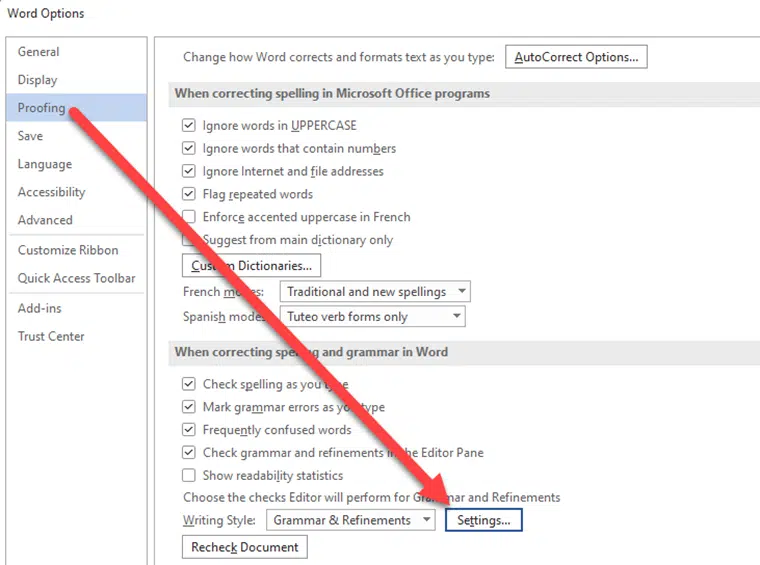Microsoft Word has a ‘profanity’ check to warn you about rude, offensive or swear words in some places. In others, the same word won’t get any special marking. We’ll explain how to setup and use Microsoft Word’s Profanity check then show its limitations and traps.
The Profanity, offensive or swear word test is in Microsoft Word 365 and Outlook 365 parts of Microsoft 365 (Office 365).
Profanity warning
We’ll be discreet in this article but the topic means there’s plenty of blurred text or asterix. Please don’t proceed if you might be offended.
Word’s Profanity check
Modern Word has an optional profanity check that’s supposed to warn about rude, offensive, obscene or bad words.
Turn it on from File | Options | Proofing | Grammar and refinements | Settings

Scroll down to the bottom, under Vocabulary look for the Profanity option.

How the profanity check is supposed to work
When Word ‘sees’ a profane word it adds a blue dotted line. Click on the word to see an explanation “This language may be offensive to your reader”.

Choose ‘Ignore’ to remove the dashes. Click the speaker icon at right to hear the word and sentence spoken aloud.
That’s how it’s supposed to work but, like so many things in Office, there’s more to it in the real world.
How the profanity check really works – or not
Word’s Profanity check mostly works only for lower case words. Anything with a Capital letter is usually ignored.
Check out this expanded version of George Carlin’s famous “Seven Words You Can Never Say on Television”.

Value judgements
One person’s plain speaking is another’s profanity.
We’re intrigued that ‘ass’ isn’t marked as an offensive word while ‘damn’ is.
Damn
We thought the argument about ‘damn’ was settled in 1939 with the release of ‘Gone with the Wind’ – video. But apparently Microsoft decided to err on the side of caution or agree with the old Hays Office.
The suggested alternatives for ‘damn’ aren’t really synonyms but are almost quaint – Oh no, Oops or Uh-oh.

Capitalization matters
In a similar way to some of the other ‘Grammar and refinements’ checks, most words starting with a capital letter are ignored.
As you can see, that’s not consistent. We can’t explain why two words on the list above are marked as ‘profane’ regardless of capitalization but other don’t.
Word’s grammar etc. checks treat most capitalized words as proper nouns and therefore ignores them. Of course, that makes no sense if the word starts a sentence but that’s a distinction Word doesn’t make.
Here’s three examples of s**t to demonstrate that only the lower-case word is marked as ‘offensive’.

Context matters, but not in Word
Of course, some words are only rude in context. We included some in our list above such as words for a sphere, child of unwed parents, a cat or someone’s behind!
Word does have some contextual spell checking but that’s not been extended to Profanity and other grammar checks.
The bottom line (no pun intended)
Don’t rely on Word’s Profanity test (among others) that there’s no ‘naughty bits’ in your documents or emails.
As you can see, there are limits to what Word will detect.
- Capitalized words are almost always ignored.
- Words with multiple meanings are always ignored with no consideration of the context.
Inside the controversial Gender Specific checks in Word
Avoid embarrassing typing mistakes in Word
How does Microsoft Word handle non-binary grammar like they?
More changes for Word’s Spelling and Grammar
The mistake in Microsoft’s ‘common grammar mistake’ list